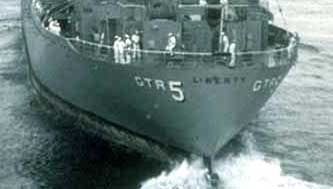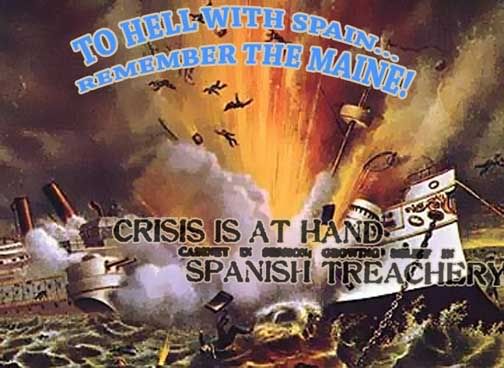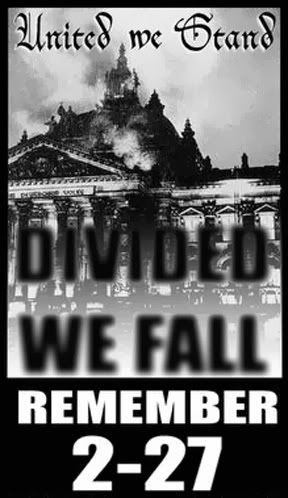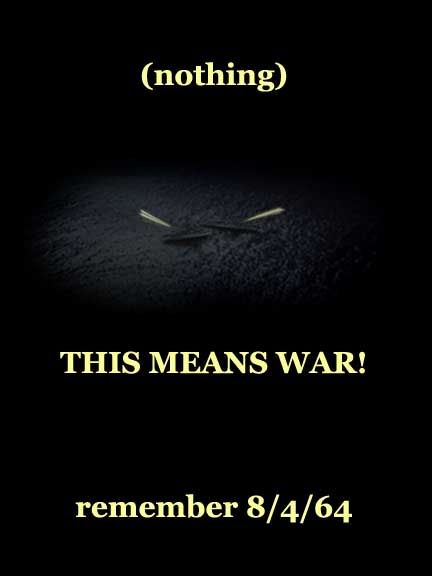Adam Larson / Caustic Logic
re-written with new info May 13 2009
last update 5/23
WHAT STOPPED THE SINKING?
The deadliest phase of the attack on the USS Liberty was the surface torpedo strike that followed twenty minutes after the air attack ended; with six torpedoes pointed at her starboard side, and under the control of those to whom everything looked Egyptian, the defenseless ship could well have been sunk. For whatever reason, and this is a bit of a mystery, only one torpedo of the five launched made its mark, blasting a 30-foot hole just below the waterline, killing 25 and causing the ship to list dangerously, but leaving her afloat and eventually able to limp towards safe harbor unaided.
The sixth torpedo was held, and never fired, as the blitzkrieg assault was finally called off. Conspiracy Theorists have long argued the intent was to fully sink the Liberty, and only fear of a confrontation with US aircraft reported en route chased them off. As the epic Admiral Thomas H. Moorer wrote in his pivotal 30-year anniversary statement on the “ridiculous” Israeli story:
“As we know now, if the rescue aircraft from U.S. carriers had not been recalled, they would have arrived at the Liberty before the torpedo attack, reducing the death toll by 25. The torpedo boat commanders could not be certain that Sixth Fleet aircraft were not on the way and this might have led to their breaking off the attack after 40 minutes rather than remaining to send the Liberty and its crew of 294 to the bottom.” [1]
The Israeli Defense Force of course claims the whole attack was horrendous error, and this part in particular is painted as a final tragic glitch – it was simply called off when they realized they were wrong. A surface reading of the presented facts looks almost like IDF Naval Headquarters became aware finally what they were attacking, and tried to stop the torpedo attack, but the message came too late, or too far to the left, or whatever, to stop the near-fatal blow. I’ve seen just this interpretation argued, and based on two separate attempted delays, in favor of the friendly fire/fog of war rationale.
Such a reading is not, however, consistent with a careful examination of the IDF’s own self-exculpations, which reveal a more troubling reality in each case.
THE FIRST CONFUSION
En route to the Liberty, the three Motor Torpedo Boats (MTBs) of Division 914, under Commander Moshe Oren, were in contact with the aircraft then attacking the ship. On this channel, they received early reports of a flagless, unidentifiable Arab Destoryer, in line with the Division’s own radar readings and reports of shelling. The problem for the attack came when the hull-marking “CTR-5” was reported to general HQ in Tel Aviv by the last attacking pilot, at 14:11. “Pay attention. This ship's markings are Charlie-Tango-Romeo 5.” [2] This was apparently not communicated directly to Division 914, but did go to their controllers at “homeland,” Air Force HQ in Tel Aviv, and from there to the Navy.
“CTR-5” is not exactly accurate, but reasonably close to the Liberty’s “GTR-5” that had been perfectly identified from the air hours earlier, and logged at Naval HQ in Haifa. Initially tagged as a US Navy supply ship, she was designated neutral by the navy chief presiding there, RADM Shlomo Erell, and by 10 am identified as the USS Liberty, spy ship. But that data was “removed from the agenda” in Haifa, as one IDF report accurately sums up, about an hour later. [3] (we’ll return to this below).
Arguably the Air Force could have and should have been aware of this known non-combatant vessel, and had their own notes to make the connection to this report, but apparently CTR-5 meant nothing in particular to them. However, it did clearly and loudly indicate one thing – it was not an Arab vessel, and Col. Shmuel Kislev instantly called the attack off with a terse “leave her.” [4] From this moment AF HQ became concerned about the ship’s identity, dreading a Soviet ID. This concern was passed to the Navy, who had their MTBs at the ready for attack – their records show it coming through to them at 1414, further garbled as “CPR-5.” [5] Michael B. Oren’s 2000 Case Closed is probably the most widely-read recitation of what happened next:
”While Egyptian naval ships were known to disguise their identities with Western markings, they usually displayed Arabic letters and numbers only. The fact that the ship had Western markings led [Gen. Yitzhak] Rabin to fear that it was Soviet, and he immediately called off the jets […] while the torpedo boat squadron was ordered to hold its fire pending further attempts at identification. Though that order was recorded in the torpedo boat's log, Oren claimed he never received it.” [6]
The early IDF sources I’ve studied generally agree that a) the hold your fire order was sent, and b) Commander Oren claimed, in testimony along the way, he didn’t receive it. Neither the Ram Ron’s nor Yerushalmi’s nor Greenberg’s connect these two in the way modern apologists sometimes do. Greenberg’s 1982 report acknowledged the ambiguity; Commander Oren “later testified that he did not receive the order from Naval Operations/3. […] However, […] an attempt was made to identify the vessel, although this was difficult due to the billowing clouds of smoke […]. As a result, the Division Commander cancelled the attack order.” Here it’s Oren’s decision due to his own inability to clear up the confusion he – wasn’t told of? This report summarizes, whatever the reason, “the end result was the same - the torpedo Division held its fire and approached the target in order to more clearly identify the vessel.” [7]
THE RESOLUTION: MIS-ID, REDUX
However, this whole controversy illustrates and draws attention to an alarming reality, as shown in the primary evidence, that the IDF allowed its confusion to be canceled out by Division 914’s ineptitude. I found an English-language copy of the MTB logs, as well as those of their controllers at Stella Maris. obtained by Judge Cristol (I do appreciate this aspect of his work). These were translated by someone he knew, and I suspect they’re pretty accurate. “Sea/3” is Stela Maris, then under Capt. Izzy Rahav. “Div” refers to Division 914, the MTBs. The order “1 9 [Tesha Vuv],” is some code that clearly means torpedo attack.
1411 – Order from Sea/3 – “We told the birds to leave after this strike, you go in.”
1415 – Aircraft left.
1419 – Going in for torpedo attack. 1 9. [Tesha Vuv]
1420 – Order from Sea/3 “Do not attack. There might be misidentification by the aircraft. Did any men go overboard? An Air Force helicopter is coming.”
1426 – Our identification indicates it may be a commercial vessel. Reported to Sea/3. Order to Div from Div CDR, Cancel 1 9 [Tesha vuv]. [8]
From this we can see the change in orders clearly transmitted from HQ, logged at 1420, and repeated from Commander Oren to his boats six minutes later. “Order to Div” means from Oren, whereas “from Sea/3 is to him. Whatever he thinks he’s talking about not receiving, it’s clear this order was received and acted on.
Yet, as we know, about ten minutes later, he ordered the Division’s torpedoes launched. The reason was not that he thought the original orders stood; rather, he and his men created a new misidentification from the ground up, negating the aircraft’s observation. Worthy of note Is that the log entries regarding this are out-of-order and unclear, running 1433, 1436, 1427?, 1435, 1437.
1427? - We tried to establish identification by light signal, “What ship?” She replied: “AA.” The vessel is all in smoke. Only the front is visible with a gun.
1435 – Div commander detected firing flashes coming from the vessel.
1437 – T-203 Identified the El Quiser, a supply ship. We checked and it seems to be reasonable. Div reported to Sea/3 that we are going in for torpedo launch. Order to Div 1 9 [Tesha Vuv]
It is corroborated by the Liberty's crew that their ship fired first, in some unfortunate error, with their weak machine guns. But no provocative "AA" (identify yourself first) message was flashed by the crew - any signal the MTBs saw was some illusion, and one that reminded commander Oren of an Egyptian ship he once encountered. [9] Given the real firing and imagined signals, plus the semi-fit with the El Quseir, Egyptian enemy perhaps seems a justifiable conclusion (the misidentification is covered more in-depth in another post). Indeed, justifications have been offered.
So, in the larger context, Naval HQ/Sea/3 starts out with incorrect news of the shore being shelled, meaning a warship. They had just finished being aware of the unarmed Liberty GTR-5. The MTBs find a radar target going 30 knots to Egyptian port – attackable speed and attackable heading and both drastically wrong. Aircraft are called in, decide in bizarre error it looks like a destroyer with cannons, and attack repeatedly. Someone finally notices a single non-Arabic clue, throwing a wrench into the previously smooth operation of error. The dumb-asses of the air Force are ordered to leave the field while the experts on the surface come in to fix things. Known to only have ID books for Arab vessels, the MTBs are tasked with re-identifying it and decided it was an Arab auxiliary ship after all and hostile. What a Mitzvah it was to have kids like the ones of Division 914 handy to clear up the confusion and make attack kosher again.
SEA 3’S ACCEPTANCE: INAPPROPRIATE
Anyone paying attention and trying the slightest to avoid a mistake would:
A) Consider that the ship they were after – capable of shelling, and clocked at 30 knots – was getting away in all this distraction with a slow unarmed confusing vessel or
B) realize that that first ship never existed, and was just this ship that had been misidentified in at least five different ways already and refuse to accept another version as the basis for a final attack and the sinking of the ship.
But T-203’s “reasonable” decision was apparently good enough for both Commander Oren and thence to Capt. Rahav at Naval HQ. Just twenty minutes earlier he had been informed of the alarming non-Arabic markings that might mean a Soviet vessel had been mistakenly attacked. Now that that vessel was found to resemble one Arab ship (so the kids are telling him) and it was shooting some kind of gun, any certainty was apparently tossed aside. Sea/3 war log, 1436, reads “identification [as El Quseir] is definite. Approval was made for torpedo attack.” [10]
By this time, of course, the IDF’s info on *GTR-5 USS LIBERTY, neutral ship, in vicinity of el Arish* was lost to the ether; a simple note, any flicker of memory of anyone present before 11:00 might have helped avoid honest confusion. But Admiral Erell, who had overseen that identification, was out of the room as of then, down at Haifa harbor for some never-explained business. As he left Capt. Avraham Lunz erased the Liberty’s neutral marker, since he felt it was gone, without telling Erell’s replacement, Rahav, that it had ever been there. [11] As reports of shelling from that area started coming in a half hour later, he ordered the MTBs in and ordered an air strike readied. By the time the attack was half-done and the hull no. was reported to Stela Maris, at 1414 (garbled as “C P R 5”), Admiral Erell who might have understood, was still away from the command center – and so confusion reigned at naval HQ, which quite quickly devolved into the torpedo attack on the Liberty.
Cristol’s book argues that Rahav may have felt obliged to allow the Div to attack, since they were under fire. [12] Oddly, war log entry for 1437, right after sink approval “The target did not open fire, the Div is shelling it with gunfire.” [13] This must be a typo or translation error as the Liberty of course did fire and the MTBs recorded it in their log – and this was apparently part of the reason to re-justify the sinking of the CTR-5 ship.
It is true that command center has a less clear view of the physical operation; they rely on reports, and have to form mental images that can be wrong. But Cristol’s assessment is worthy of note here; first, hypothesizing Rahav’s awareness of the shooting, but not of their El Quseir ID, he mused “if the MTBs were engaging an Egyptian destroyer, they were in mortal danger,” and Rahav’s re-authorizing the suspended Tesha vuv order “was appropriate.” After this thought exercise, Cristol offers no evidence Rahav still though it was a destroyer. In fact, the author provides a small handful of clues to the contrary – he should have realized this was not a deadly warship, as had been presumed during the air attack. His authorization was based on the ID as El Quseir, which is nowhere near a warship. “Nevertheless, Rahav responded “Tesha Vuv approved.”” [14] Whether he meant to or not, Cristol is explaining how this decision was not appropriate in response to a mis-identified small vessel armed only with machine guns. Of course, it’s hard to get around the sense that something went wrong here, and inappropriate is perhaps softening the reality, but it’s at least a step past knee-jerk absolvism.
CANCELED AGAIN/LINGERING DOUBTS
In his book, Cristol cites no controversy over the 14:20 “do not attack” order, taking as evident that fire was held until re-approved based on the “definite” Arab ID and some kind of “firing.” He instead places the controversy of Oren and his orders over a different attempted halt – from Admiral Erell himself, who had just then returned and ordered the attack stopped.
Ironically, Admiral Erell.’s own son Udi was among the MTB crew flailing in the dark just when his Dad’s knowledge was most needed – in fact, on the crew of T-203, who fired the successful hit. His knowledgeable father remained out for almost exactly the duration of the disaster, according to Judge Cristol, returning from the harbor apparently just after Rahav gave his approval for tesha vuv, but before the torpedo strike was reported – so between 1436 and 39 Sea/3 time. He quickly sent word to halt the attack – there had been a mix-up. “Commander Oren stated he did not receive the order,” Cristol writes, but “there is evidence that the order was received by the CIC officer on MTB 204.” Though he has no citation, and the MTB log at least shows no such order from Sea/3 at this time. [15]
The Liberty’s logs show the first torpedo pass at 1434 and the impact of the second at 1435 – eight minutes before the MTB log entry noting it at 1443. Other points support a time offset of about 8 minutes between their chronologies (MTBs ahead). So to avoid confusion, I’m dealing in MTB log time, by which the attack was canceled by Commander Oren at 1447, four minutes after the torpedo hit. The Div also seems ahead of Sea/3, by about four minutes, so I specify by whose time. Sea/3’s log reports torpedo hit at 1439, and their 1443 entry has the first thing like a cancellation; “if the target is sinking, stop fire and take survivors.” [16] This does correspond with Oren’s cancellation, but that was announced with the cryptic 1447 entry “One more attack. After identification of mark, order to the Div to cease fire. Attack called off.” [17] His decision was apparently informed less by any order from Sea/3 than by “identifying” a “mark.” Just what is not explained.
Sea/3’s 1446 entry (1450 MTB time, so a bit late) explains “The Div reports the marking is C T R 95.” [18] The 9 is an unusual variation I can’t imagine them actually seeing, so likely just a typo, and again, we’re presented with that giant “5” and mysterious CTR prefix that reads clearly in Hebrew as “not Arab.” This exact finding is not mentioned in the MTB’s log, but clearly the mark they noted is the same one the pilots had reported 30 minutes earlier. It was apparently enough for Oren to call it off over, and he was denied two different sources (Sea/3 and the aircraft direct) for variations of that mark. This does not excuse the decision to sink the ship, but it is curious how key facts just refused to get to the right people, spreading the blame around as Division 914 undid their predecessors’ findings only to re-create them again ten minutes and five torpedoes later.
Interestingly, Cristol’s book fails to mention the early identification of the ship’s “mark,” seen at the bow of the ship, right side, as he argues for utter confusion that lingers. * He does mention the episode five minutes later when some letters were found on the back of the ship that indicated to them Soviet. But not the giant letters on the front five minutes earlier. [19] The reason for this omission is not entirely clear.
* Note: I goofed this - the same identification, along with the name "LIBERTY" are on the rear of the ship. Took me a while to find a photograph of this. So they could have seen "the mark" at either end. But again, their log puts it at 1447. Sea/3's 1451: "My [sic] be Russian nationality, based on writing on aft," matches the MTB log's 1451: "Report to C3: "Vessel may be Russian [...] based on writing on back of vessel." Da, "Liberty" does have that Stalinist flavor, don't it? Can't read English? They could have spelled it out like they did C-T-R. But they apparently missed it until just before their 1640 entry where "Liberty" is first mentioned nearly two hours after they first floated past it.

Sources:
[1]Moorer, Thomas H. Adm. “Attack on the USS Liberty, June 8,
1967.” Memorandum to Americans for Middle East Understanding. June 8 1997. http://web.austin.utexas.edu/chenry/usme/moorer.html
[2], [4] Air-Ground communications, transcript. Jerusalem Post, 2004. 14:11. My re-post.
[3], [7] Greenberg, Matti, Lt. Col. "The Attack on the Liberty Incident." Israeli Defense Forces history department. 1982.
[5] Israeli Defense Forces. Sea Section/3 war log. WARLN. June 8 1967. English language translation. PDF available at: http://www.thelibertyincident.com/israellogs.html
[6] Oren, Michael B. The 'USS Liberty': Case Closed. Azure, Spring 2000. http://web.archive.org/web/20000917231200/http://www.azure.org.il/9-Oren.htm
[8] Israeli Defense Forces. Division 914 war log. WARL914. June 8 1967. English language translation. PDF available at: http://www.thelibertyincident.com/israellogs.html
[9] See 6, also Cristol p53, etc.
[10] ...
[19] Cristol, p. 57













No comments:
Post a Comment